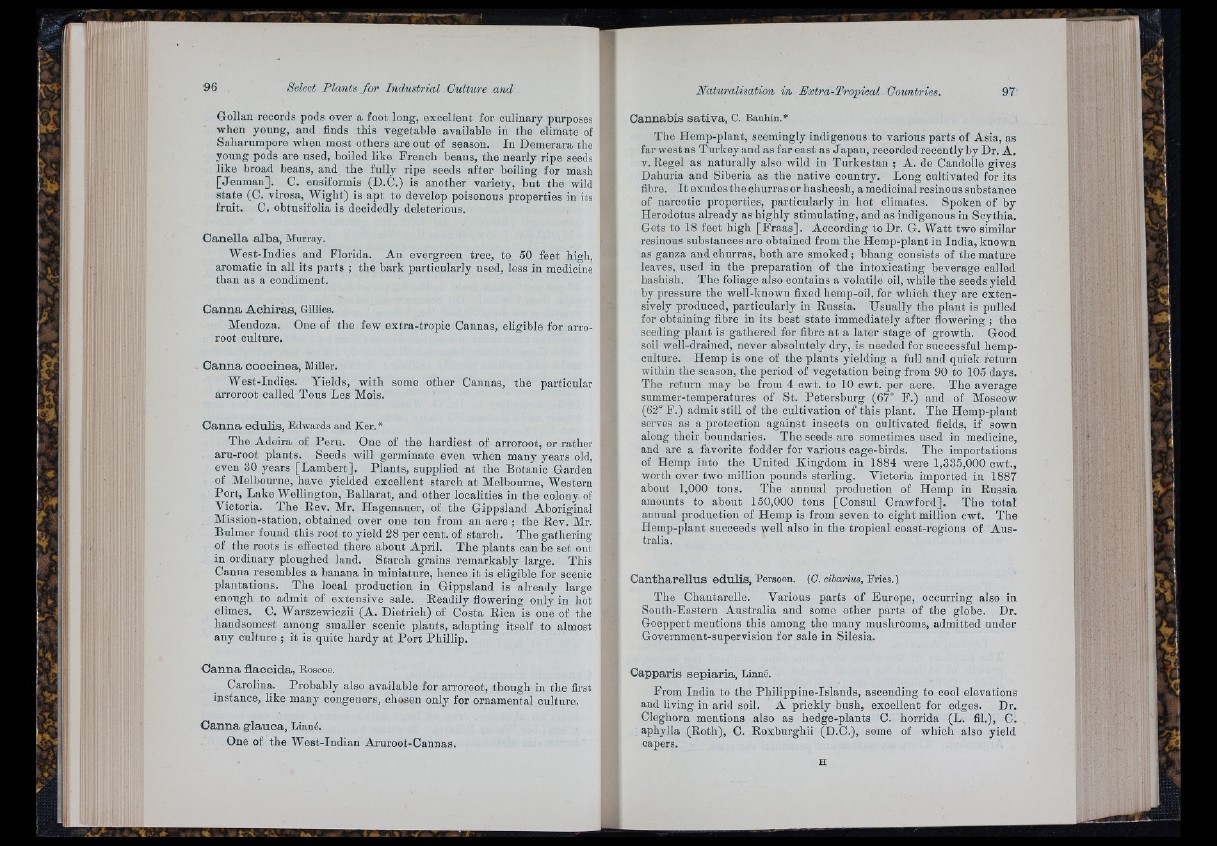
Gollan records pods over a foot long, excellent for culinary purposes
when young, and finds this vegetable available in the climate of
Saharumpore when most others are out of season. In Demerara the
young pods are used, boiled like French beans, the nearly ripe seeds
like broad beans, and the fully ripe seeds after boiling for mash
[Jenman]. C. ensiformis (D.C.) is another variety, but the wild
state (C. virosa, Wight) is apt to develop poisonous properties in its
fruit. C. ohtusifolia is decidedly deleterious.
C a n e lla a lb a , Murray.
West-Indies and Florida. An evergreen tree, to .50 feet high,
aromatic in all its parts ; the bark particularly used, less in medicine
than as a condiment.
C a n n a A c h i r a s , Gillies.
Mendoza. One of the few extra-tropic Gannas, eligible for arro-
root culture.
C a n n a o o c c in e a . Miller.
West-Indies. Yields, with some other Canuas, the particular
arroroot called Tons Les Mois.
C a n n a e d u lis , Edwards and Ker.*
The Adeira of Peru. One of the hardiest of arroroot, or rather
aru-root plants. Seeds will germinate even when many years old,
even 30 years [Lambert]. Plants, supplied a t the Botanic Garden
of Melbourne, have yielded excellent starch at Melbourne, Western
Port, Lake Wellington, Ballarat, and other localities in the colony of
Victoria. The Rev. Mr. Hagenauer, of the Gippsland Aboriginal
Mission-station, obtained over one ton from an acre ; the Rev. Mr.
Bnlmer found this root to yield 28 per cent, of starch. The gathering
•of the roots is effected there about April. The plants can he set out
in ordinary ploughed land. Starch grains remarkably large. This
Canna resembles a banana in miniature, hence it is eligible for scenic
plantations. The local production in Gippsland is already large
enough to admit of extensive sale. Readily flowering only in hot
climes. C. Warszewiczii (A. Dietrich) of Costa Rica is one of the
handsomest among smaller scenic plants, adapting itself to almost
any culture ; it is quite hardy at P o rt Phillip.
C a n n a b is s a t iv a , C. Bauhin.*
The Hemp-plant, seemingly indigenous to various parts of Asia, as
far west as Turkey and as far east as Japan, recorded recently by Dr. A.
V. Regel as naturally also wild in Turkestan ; A. de Candolle gives
Dahuria and Siberia as the native country. Long cultivated for its
fibre. I t exudes the cliurras or hasheesh, a medicinal resinous substance
of narcotic properties, particularly in hot climates. Spoken of by
Herodotus already as highly stimulating, and as indigenous in Scythia.
Gets to 18 feet high [F ra a s]. According to Dr. G. Watt two similar
resinous substances are obtained from the Hemp-plant in India, known
as ganza and churras, both are smoked; bhang consists of the mature
leaves, used in the preparation of the intoxicating beverage called
hashish. The foliage also contains a volatile oil, while the seeds yield
by pressure the well-known fixed hemp-oil, for which they are extensively
produced, particularly in Russia. Usually the plant is pulled
for obtaining fibre in its best state immediately after flowering ; the
seeding plant is gathered for fibre a t a later stage of growth. Good
soil well-drained, never absolutely dry, is needed for snooessfnl liemp-
culture. Hemp is one of the plants yielding a full and quick return
within the season, the period of vegetation being from 90 to 105 days.
The return may be from 4 cwt. to 10 cwt. per acre. The average
summer-temperatures of St. Petersburg (67° F.) and of Moscow
(62° F.) admit still of the cultivation of this plant. The Hemp-plant
serves as a protection against insects on cultivated fields, if sown
along their boundaries. The seeds are sometimes used in medicine,
and are a favorite fodder for various cage-birds. The importations
of Hemp into the United Kingdom in 1884 were 1,385,000 cwt.,
worth over two million pounds sterling. Victoria imported in 1887
abont 1,000 tons. The annual production of Hemp in Russia
amounts to about 150,000 tons [Consul Crawford]. The total
annual production of Hemp is from seven to eight million cwt. The
Hemp-plant succeeds well also in the tropical coast-regions of Australia.
C a n th a r e l lu s e d u lis , Persoon. ((7. cibarius, Eries.)
The Chautarelle. Various parts of Europe, occurring also in
South-Eastern Australia and some other parts of the globe. Dr.
Goeppert mentions this among the many mushrooms, admitted under
Government-supervision for sale in Silesia.
;■ '.v,7
..t '-/fr;
C a n n a f la c c id a , Rosooe.
Carolina. Probably also available for arroroot, though in the first
instance, like many congeners, chosen only for ornamental culture.
C a n n a g l a u c a , Linué.
One of the West-Indian Aruroot-Cannas.
Capparis sepiaria, Linné.
From India to the Philippine-Islands, ascending to cool elevations
and living in arid soil. A prickly bush, excellent for edges. Dr.
Cleghorn mentions also as hedge-plants C. hórrida (L. fil.), C.
aphylla (Roth), C. Roxburghii (D.O.), some of which also yield
capers.